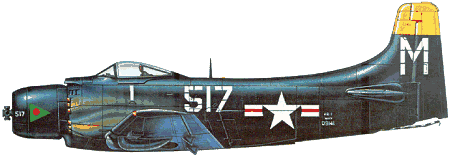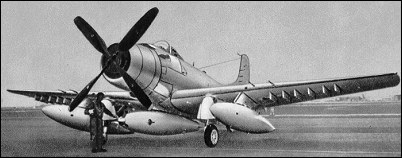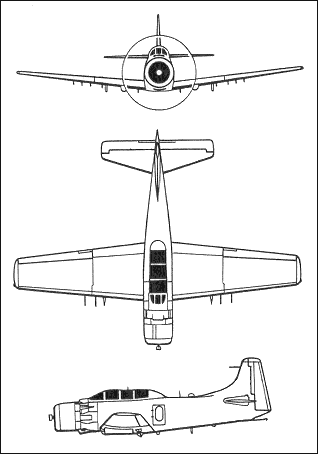|
| Developed to satisfy a US Navy requirement of 1944 for a single-seat carrier-based dive bomber and torpedo carrier, the Douglas AD Skyraider (as it became designated) materialised too late for operational service in World War II. Ordered into production alongside the Martin AM Mauler, which had been developed to meet the same specification, it was to continue in production until 1957; although Martin's aircraft was taken off the production line after 151 had been built.
The Skyraider reflected the navy's wartime experience gained in the Pacific theatre, where it had been proved that the most important requirement for such aircraft was the ability to carry and deliver a heavy load of assorted weapons. Of low-wing monoplane configuration, a big Wright R-3350 radial engine was selected as the most suitable power plant to meet the load-carrying requirement, and this more or less dictated the fuselage proportions. The prototype XBT2D-1 flew for the first time on 18 March 1945. When production terminated 12 years later 3,180 aircraft had been built in many variants.
Although too late for World War II, Skyraiders were successfully deployed in both the Korean War and in Vietnam. Steady development led to the introduction of new power plant and equipment and the AD-5 was one of the most versatile military aircraft in US service. It differed significantly from earlier versions by having a wider and lengthened fuselage and providing side-by-side seating for two crew; specially designed quick-change kits were available so that the basic AD-5 could be utilised as a 12-seat transport, as well as for freight-carrying, ambulance and target-towing roles. When the US tri-service designations were rationalised in 1962, AD-1 to AD-7 versions became redesignated from A-1A to A-1J.
In addition to serving with the US Navy, Skyraiders have been operated also by the USAF and with the Royal Navy, French and Vietnamese Air Forces among others.

| MODEL | AD-7 (AD-1J) |
| ENGINE | 1 x Wright R-3350-26WA, 1985kW |
| WEIGHTS |
| Take-off weight | 11340 kg | 25001 lb |
| Empty weight | 4785 kg | 10549 lb |
| DIMENSIONS |
| Wingspan | 15.47 m | 51 ft 9 in |
| Length | 11.84 m | 39 ft 10 in |
| Height | 4.78 m | 16 ft 8 in |
| Wing area | 37.16 m2 | 399.99 sq ft |
| PERFORMANCE |
| Max. speed | 515 km/h | 320 mph |
| Ceiling | 7740 m | 25400 ft |
| Range | 1448 km | 900 miles |
| ARMAMENT | 4 x 20mm cannon, 3629kg of bombs |
| Bob S, e-mail, 12.03.2011 01:28 Hi I enjoyed mr RJ Stantons information except for one thing - the SkyRaiders I worked on from 1962 -1966 while I was with VA25 in the Navy aboard the USS Midway were all painted Gray & White after we turned our planes over to the Airforce they painted them a nasty camo paint job - the Last of VA25's Skyraiders now lives in Pen. Fla.(flown there by Ted Hill) in the Museum and is still painted Navy Gray & White. best regards Bob reply | | uncle-mac, e-mail, 10.03.2011 20:11 Where did class 7-57 go.- Flew the 5,6,7, in the Ferry command VRF-32 Great cross country A /C Just missed the Marines at Lemore for Survival school as they grabbed who they could. Took a 6 into Green Bay to see the lady friend. Caused quite a sturrr reply | | R.Thomas Kingzett, e-mail, 02.03.2011 15:15 Station with VAW-11 1960 to 6 /61...transferred to VAW-13
with members of Det Mike from VAW-11 July 1961.Served on many Dets 61-thru-64. Skyraiders and the 3350 were a way of life. Love It. !! reply | | Robert J. Stanton, e-mail, 28.02.2011 05:31 I worked at Douglas Aircraft, El Segundo, CA. from 1952 till 1956. I didn't have the wonderful experience of the LUCKY men who got to fly that "Work Horse", the AD's, 5 & 6, SKYRAIDERS but I spent some of that tme at the B3 Hnagar facility on Imperial Blvd., at LAX. Today this is the FEDEX location at LAX. This is the place where the AD's were delivered to the USN. I did some final inspections, to see if the part numbers on many of the electronics and engine parts matched the manifest of the planes fuselage number. Also loaded on board many of the loose items that were delivered along with the aircraft. That plane was a RUGGED machine. During this time period, there were still some enlisted Petty Officers pilots, left over from WWII that picked up the planes from the factory and delivered them to their first duty station. They came from the factory in their NAVY blue paint. They didn't get their gray paint jobs until they were turned oveer to the Airforce and became A-1 SKYRAIDERS. I have some great memories of that rugged, beautiful aircraft!! reply | |
| | 'Jess'e Garrett Forsythe, Jr, e-mail, 15.02.2011 21:04 Flew the AD-4 & -3 61 missions in Korea starting at Inchon 9 /15 /1950. Saved me fron an electical fire (400 hz ac system) and recovered gently from an approach stall at the 90deg position. Now a photo of this Fist of the Fleet (VA-65) aircraft is my computer 'wallpaper' with me in the cockpit! reply | | Donald Hess, e-mail, 22.01.2011 18:09 WAS WITH VA-215 59 /61 AS A AMS- CRUISE 7TH FLEET 77TH TASKFORCE CAG 21 OFF THE LEXINGTON /MOFFITT FIELD - DIDN'T GET THE HONOR OF FLYING ONE BUT DID LOVE WORKING ON THEM. HAD SOME FINE PILOTS FLYING THEM (LT JOHNSON,GRIMES, TASKAVICH TO NAME A FEW. IF LT JOHNSON EVER READS THIS I STILL OWE HIM A CIGAR FOR THAT LAST FLY BY OF THE SHIP. reply |
| Howard L New AZC USN Ret, e-mail, 22.01.2011 05:53 I am a plankowner of VAW-13 NAS Guam. I was in Det. Delta that left VAW-11 aboard the Hancock that formed VAW-13 at Guam. Stayed there until VAW-13 changed homeports.
Capt Edwin Nile Hitchcock was the Skipper and LCDR Robert John Brunskill the Maintenance Officer reply | | Ron "Banty" Marron, e-mail, 15.01.2011 05:05 Failed to mention...your email addy does not work!! reply | | Ron "Banty" Marron, e-mail, 15.01.2011 05:04 PING: Larie Clark...
Larie Clark, clarkfl5=aol.com, 29.10.2010
Looking for the Spad Squadron and pilots off the USS Saratoga who crash landed two spads in Central Algeria while on the 1962 /1963 Med cruise. Held captive for several weeks and escaped to the US Embassy
Be in touch...I'm your man... reply | | Rich Frost, e-mail, 08.01.2011 02:34 1958 assigned to VAAW35 NAS North Island San Diego. Our 4 plane detachment(AD5Ns) went to WESPAC on Ranger CVA 61. Was ATN3. Earned my Combat Aircrew Wings. Operated Radar, ECM, and Navigation. On return to CONUS transfered to VAW11 and detached to Yorktown CVS 10. Flying in AD5Ws (Guppy) as airborne controller for ASW exercises. Trained officers for this job on return to North Island. Got out 9 /60 as AT2. reply | | CDR Lanny Cox, USN (Ret), e-mail, 03.01.2011 22:38 Flew the AD-6 /7 while completing Advanced Flight Training at VT-30 in Corpus Christi, TX. Received my "Wings of Gold" and orders to VA-152 in Oct 1964 and traveled to VA-122 at NAS Lemoore, CA for further training in the SPAD. While at VA-122, received a change of orders sending me to VAW-13 to fly the EA-1F Electronic Warfare version of the aircraft. Flew 135 missions over and around North Viet Nam supporting air wing strikes from VAW-13 detachments aboard USS Oriskany, Bon Homme Richard, Independence, Ranger, Constellation, Intrepid, Midway, Coral Sea, and F.D. Roosevelt. Always enjoyed flying the SPAD whether single seat or EA-1F or A-1E. A great machine! reply |
| CDR Jim Glendenning, e-mail, 02.01.2011 20:32 A bit over 2000 hours in the SPAD. Great airplane and fun to fly. Flew it as an all-weather interceptor in South Vietnam and as an ECM platform over North Vietnam.
Also did some test flying O&R Alameda on the A-1Es that were converted for the USAF Air Commandoes to fly in South Vietnam. Many memories. reply | | Bill Spradley, e-mail, 20.12.2010 19:04 We had 2 AD-5N's at Natc Pax River from 61-64. I flew in them as an ECM operater. We also used them as a 4 passenger transport. Great airplane, I loved flying in them. And yes they coulfly very slow, barely hanging by the prop. One pilot I flew with liked to play games with people by just mushing along at about 80 knots. reply | | Joe Scanlon, e-mail, 11.12.2010 19:22 I was an engine Mech on the A1E in Nam 65 to 66. We started in Bien Hoa then moved to Nha Trang and i finished my tour in Udorn, Thailand. Got to fly right seat several time on ferry trips to NKP where the Spads flew cover for the Jolly Greens. It was a great aircraft with a wonderful engine. One time on a post flight check i found a bullet hole in the nose case of the engine where the reduction gear is located. There had been no grips written up by the pilot. reply | |
| | William (Bill) Davidson, e-mail, 30.11.2010 17:13 I was a titles wave (Yeoman) in VF-193 1954 – 1955. VF- 193 was part of CAG 19. The CAG's home port was Moffitt Field, Sunnyvale, CA. Being a black shoe I didn't fly much but because I was the designated court recorder, I was sometimes flown to TAD sites to set up and run courts marshals. One time, I believe in late 1954, I was flown to NAS Fallon, NV in an AD5 trainer with the two seats side by side and duel controls. The pilot who took me was none other than then Lt Allan B. Shepard, Jr. God bless his soul.
I had the ride of my life that night. It almost scared me to death but I would do it again if I could. I suspect that some of the maneuvers Mr. Shepard performed and where they were performed may have been against regulations so I won't go into detail and most readers wouldn't believe me anyway.
I am currently writing a book that involves the Ads and have questions that someone who flew the aircraft could answer. Please contact me. If you contact me I will be happy to send you a copy of my book "Brothers Through Honor", an historical novel about WW2. If you would like to purchase a copy, it is on Amazon reply | | William (Bill), e-mail, 30.11.2010 02:21 I was a titles wave (Yeoman) in VF-193 1954 – 1955. VF- 193 was part of CAG 19. The CAG's home port was Moffitt Field, Sunnyvale, CA. Being a black shoe I didn't fly much but because I was the designated court recorder, I was sometimes flown to TAD sites to set up and run courts marshals. One time, I believe in late 1954, I was flown to NAS Fallon, NV in an AD5 trainer with the two seats side by side and duel controls. The pilot who took me was none other than then Lt Allan B. Shepard, Jr. God bless his soul.
I had the ride of my life that night. It almost scared me to death but I would do it again if I could. I suspect that some of the maneuvers Mr. Shepard performed and where they were performed may have been against regulations so I won't go into detail and most readers wouldn't believe me anyway.
I am currently writing a book that involves the Ads and have questions that someone who flew the aircraft could answer. Please contact me. If you contact me I will be happy to send you a copy of my book "Brothers Through Honor", an historical novel about WW2. If you would like to purchase a copy, it is on Amazon. reply | | Lew Daugherty, e-mail, 24.11.2010 17:22 We started the SANDY mission with the A1E out of UDORN in late 65, patterned after the NAVY missions. We located downed aircrews up north and covered pickups by Jolly Green choppers reply | | Pete Weiland, e-mail, 17.11.2010 00:30 I flew AD-3, Ad-4, AD-4N, AD-5 and AD-5Ws. The plane was rugged and always brought you back. I lost all my oil one day but made it back to Barin Field for a dead stick landing. In an AD-4 I was practicing stall /spins when the plane snap rolled into an inverted spin. It took me 7,700 feet of the 8,000 feet I started with to figure out how to get out of that predicament. In the Med one night I was 75 miles from the USS Intrepid when the red light went on indicating metal chips in the oil sump. I made it back and the mechs took a large pail full of chips out of the sump. The engine had only moments of life left. What a great plane. reply | | tokyoraider, e-mail, 11.11.2010 03:22 I went to Naples Italy for my first duty station after "A" school in Millington TN. I flew in the AD-5 Skyraider as the towreel operator and then as crew chief. We would tow targets for fleet gunnery pratice. I have loged several hundred hours in the AD-5 and it was a great plane. reply | | W E Steinwedell, e-mail, 30.10.2010 00:42 Cag 4,NAS Jacksonville, Fl 1956-1958: 1956 shakedown cruise on the Sara to Gitmo. 9 month cruise in the Med in 1957-58: Re: aircraft specifications noted above- max ceiling 25,400 ft. I recall the "Spad" manuel noted a max ceiling was 32,500 ft. I instinctively knew that the AD could fly higher and on one hop with 2 empty 300 gal external fuel tanks, got as high as 39.600, hanging their at the stall and full throttle. I couldn't go any faster or slower, and missed angles 40 by 400 ft. When the oil pressure light went red, I kicked the rudder, extended the dive breaks and split "S'd" back down...... My longest Sandblower-low level flight was over 13.5 hours. Now that was a long day..... May I add, that an AD6 doesn't" float worth a damn.....Splash reply |
|
Do you have any comments?
|
| 
COMPANY
PROFILE
All the World's Rotorcraft
|




 CDR Lanny Cox, USN (Ret)
CDR Lanny Cox, USN (Ret)




I ALSO WAS WITH VA-215 DURING 59 /62 AS A AME AND CRUISED WITH THE 7TH FLEET CAG 21. I CHANGED MANY O2 TANKS AND GAUGES UNDER THE COCKPIT DASH. I REMEMBER LT GRIMES LT JOHNSON AND TASKAVICH. I REMEMBER HELPING THE PARACHUTE RIGGERS IN THE FANTAIL LOFT ON THE LEXINGTON. LOTS TO REMEMBER NOW THAT I AM 80 YEARS OLD. AT SEA REPLENISHMENT PARTIES. SLUCH FUNDS, SECRET POKER GAMES. STEALING FRESH LOBSTERS FROM THE MESS FOOD SUPLY. SLIPPING FOOD TO THE GUYS ON BREAD AND WATER IN THE BRIG BETWEEN SLICES OF BREAD. ALL GREAT MEMORIES. HOPE YOU ARE DOING FINE. JOE MCGIFFIN AME3
reply